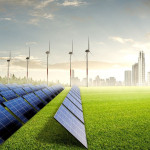Top 10 Renewable Energy Trends in 2023
1. **Innovations in Photovoltaics:** Solar energy companies are revolutionizing the industry with integrated PV systems that blend seamlessly into various environments, reducing land usage. Notable trends include floatovoltaics and agrivoltaics. Startups are also introducing flexible, lightweight, and eco-friendly thin-film solar cells. Enhanced PV materials like perovskite are boosting energy conversion rates, while novel designs maximize efficiency and sustainability through resource recycling and alternative materials.
2. **Artificial Intelligence and Big Data:** Big data and AI are transforming the energy grid, enabling real-time decision-making and predictions. Beyond grid management, AI aids in consumption forecasting, predictive maintenance, and energy trading. Cloud computing and virtual power plants bolster energy generation. Startups employ data analytics and machine learning for energy modeling and performance assessment.
3. **Distributed Energy Storage Systems:** To address renewable energy intermittency, startups offer various energy storage solutions, including flow batteries, solid-state batteries, capacitors, and supercapacitors. Batteryless alternatives like pumped hydro and compressed air systems gain traction. Power-to-X (P2X) technology converts excess energy into other forms for storage.
4. **Hydropower Advancements:** Hydropower's reliability and energy density make it a focus. Startups develop innovative energy converters for dams and ocean-based energy generation, optimizing efficiency. Small-scale hydroelectric dams and tidal barrages enable decentralized energy production. Ocean thermal energy conversion (OTEC) harnesses temperature gradients.
5. **Wind Energy Evolution:** Ongoing advancements in wind energy technology include offshore and airborne wind turbines, often integrated with other renewables. Blade design, aerodynamics, and generator efficiency improvements boost overall performance. Innovations tackle blade material sustainability through recyclable materials and bladeless technologies.
6. **Bioenergy Innovations:** Biomass-derived bioenergy gains attention, with improved biofuel processes and upgradation techniques for liquid biofuels. Fermentation produces bioethanol from waste, food grains, and plants. Synthetic biology aids in algal bio-oil production, contributing to fuel quality and reducing greenhouse gas emissions.
7. **Grid Integration Technologies:** Energy-efficient technologies like GaN and SiC semiconductors enhance grid transmission and distribution. Microcontroller-based solutions stabilize variable energy generation. Vehicle-to-grid (V2G) and grid-to-vehicle (G2V) technologies support grid stability and energy trading.
8. **Green Hydrogen Development:** Green hydrogen gains momentum as a clean fuel source. Startups tackle challenges in storage, transport, and distribution. Hybrid systems that combine green hydrogen with lithium-ion batteries offer sustainable solutions for energy storage.
9. **Advanced Robotics in Renewable Energy:** Robotics and automation optimize renewable energy production and maintenance. Autonomous cleaning robots for solar panels and drone-based inspections enhance efficiency and safety. Robotics technologies improve overall system performance.
10. **Blockchain for Energy:** Blockchain technology ensures secure transactions in renewable energy sectors. Smart contracts facilitate P2P electricity trading and data encryption protects grid operations. Blockchain-based reward systems incentivize the transition to distributed renewable energy.
These trends exemplify the renewable energy sector's dynamic growth and innovation, signaling a greener, more sustainable future.



